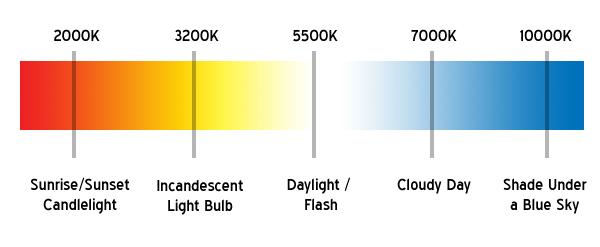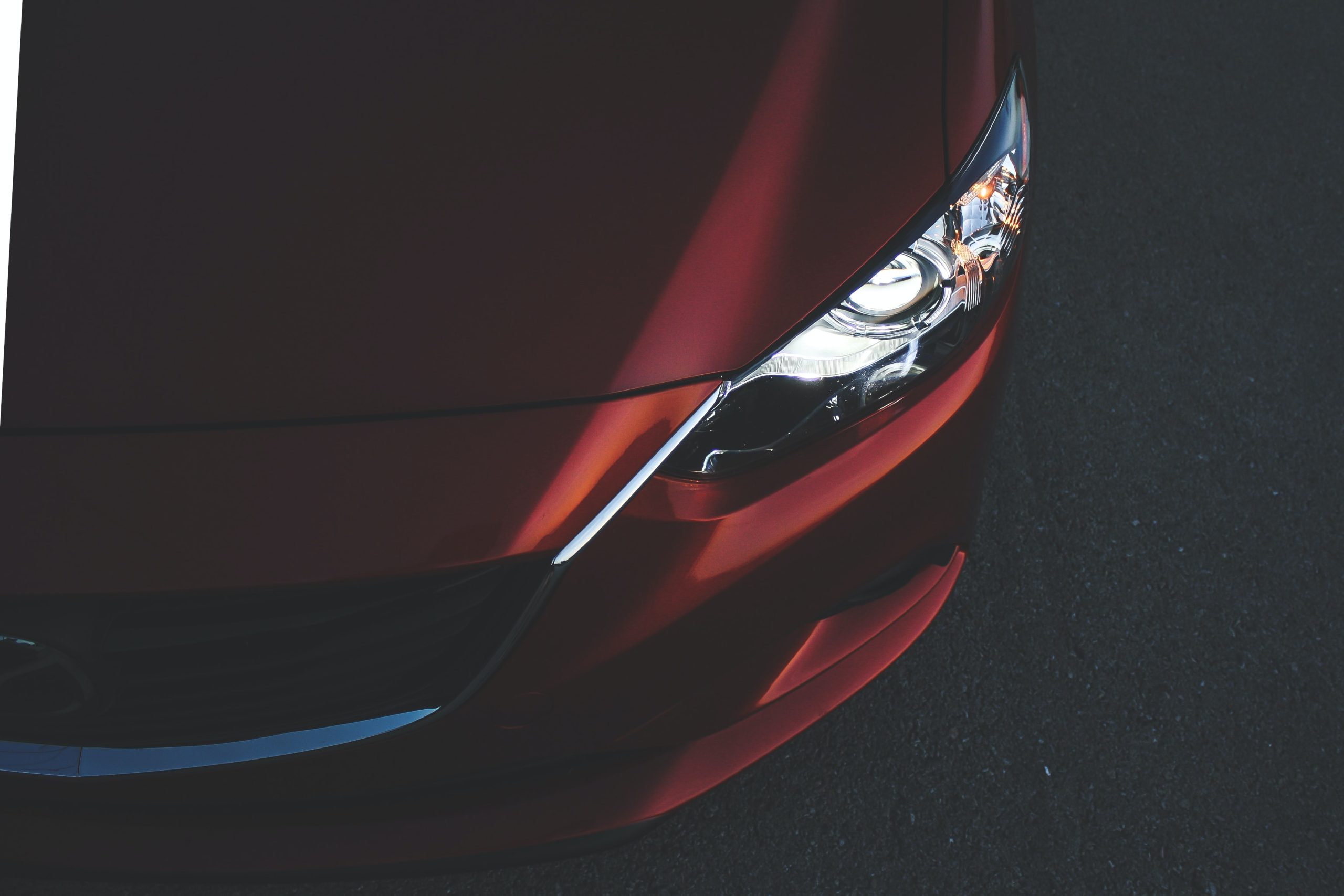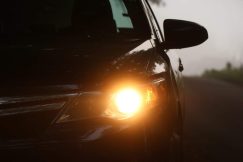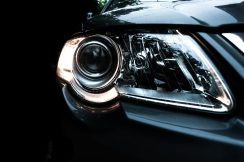What is the best HID color? This question comes up a lot, so we wanted to put this to rest. Keep in mind that “best” is subjective, but most are trying to strike the optimal balance of style and light output performance. If this is you, read on, use our HID color chart, and find the color that’s right for you.
Consider an HID conversion kit if your vehicle doesn’t come equipped with HID headlights from the factory.
The Best HID Color: 5000K – 6000K
The color temperature of 5000K to 6000K most closely resembles sunlight, which the human eye sees best. It’s that simple. So to answer the question once and for all: What is the best HID color? 5000K or 6000K is the answer.
Read on to learn more about what this means.
HID Headlight Color Chart
HID headlight bulbs come in a full spectrum of colors. Each color in the color chart below serves a specific purpose. As a general rule, colors on the lower and higher extremities are often used for style, with very little function. Colors near the middle of the spectrum are ideal for headlight nighttime visibility and can also offer some very clean styling.

| COLOR | COLOR TEMPERATURE | DESCRIPTION |
| Yellow | 3000 K | Pure Yellow light emission is commonly found in halogens. |
| OEM White /OFF- white | 4300K | Yellowish-white emission is similar to dim white light. |
| Pure White | 5000K | Pure white light emission. Simulates natural light |
| Crystal White | 6000K | Pure White light emission with a bit of blue. |
| Light Blue | 8000K | A bluish-white light emission with more blue percentage. |
| Blue | 10,000K | Dark Blue light bordering on violet. |
| Violet | 12,000K | Dark Violet. |
What is Color Temperature?
Color temperature is the color designation given to each hue in the spectrum depending on how the naked human eye sees it. Color temperature is measured in Kelvin, which is the unit of absolute temperature and can be converted to Lumens, the brightness emitted. As seen on the chart, the higher the color temperature, the less valuable the light becomes, and visibility decrease, contrary to popular belief that a higher temperature equals more brightness.
Deciphering Color Temperature and Light Purpose
Yellow Light (3000K)
- Yellow light is commonly found in the form of Halogen lamps and is often found in old car models. Yellow light is suitable for bad climates because it can cut through air moisture as compared to white light. It is perfect for conditions involving fog, snow, sleet, rain, and storms. Thus, it is the best HID color for visibility.
OEM/Original Equipment Manufacturer HID Light (4300K)
- White light with a hint of yellow is a usual standard for factory-released HID. The light resembles dim lighting or the natural sunlight output. This color maximizes light output.
Pure White Light (5000K)
- Pure white light imitates clear sunlight and is considered the best HID color temperature. This hue is most compatible with people’s eyes because it is a compromise between blue and yellow.
Crystal White Light (6000K)
- Crystal White Light is the highest perceivable Kelvin color. It is a white light with more blue undertones and can also be considered a good color temperature. This is also known as an aftermarket HID install and may be bought in HID kits. 5000-6000K is the best range in the color temperature spectrum the human eyes were made to detect such, and the best HID color for night driving.
Light Blue (8000K)
- Anything higher than 6000K is only used for aesthetic purposes. Bluish light is not recommended for road use due to intense glare and decreased visibility. 8000K and 12,000K lights are customized as car show cosmetics.
The best HID color for headlights should mimic natural lighting or near sunlight conditions. The human eyes are intended to detect light color conditions in their most natural form.
Yellow Fog Light
Fog lights are a major necessity in any vehicle, particularly in places where the climate is unpredictable. Fog lights also light the sides of the road giving the driver a wider path to see, letting him manipulate the vehicle better.
Fog lamps have been traditionally colored yellow, and the origin of the practice is hard to determine. A nugget of history shows France having a big role in the yellow fog light fever. The French apparently made use of yellow headlamps as a strategic way to identify foreign cars and foreign nationalities at night. They completely removed any other color tinge in the light spectrum, leaving only a blast of pure yellow light. This movement was known as the “Selective Yellow Light.”
For many years, the most common bulbs used were either incandescent or halogen bulbs, but these days people have the option to use Xenon bulbs or LED.
Advantages of a Yellow Fog light
- A yellow fog light performs better in poor visibility: Many would claim that yellow “slices” through the haze, fog, smoke, and similar conditions, but light does not have the ability to do so. Actually, yellow light is better in these conditions because human eyes can detect them better than other colors like blue or violet.
- Warmer colors as such would be easier on the eyes as compared to whites and blues.
Disadvantages of Yellow Fog Lights
- Amber lights leave most dark objects invisible: Although most reflective signs can be spotted a mile away, animals, rocks, debris, and small things are hard to spot with these lights. Similar lights at home, it is often harder to spot stuff when the light is dimmer.
- Yellow fog lights produce less cornering illumination: Yellow lights used in beaming sides would be less efficient compared to using brighter versions like white.
Blue Headlights
With the surge of technology, cars can now be easily equipped with stylish, functional accessories or customized as a whole. HID bulbs became a hit due to their ability to produce crisp, bright lights and most luxury vehicles sport blue headlamps.
Pros of Blue Headlights
- Blue headlamps are stylish: Blue headlights are now a status symbol. Cars fitted with such seem more expensive, not to mention maintaining HID lights is definitely costly.
Cons of Blue Headlights
- Blue headlamps are annoying to incoming traffic: Many people complain about these headlamps because of the unpleasant experience of being flashed with blinding brightness.
- Blue lights are illegal in some places: Even though it is now a trend, most states still consider blue lights illegal, so having one would definitely cause problems if the driver is not aware of the road policies in a certain area.
- Blue lights cause eyestrain: Similar to gadget use, constant exposure to blue lights can trigger eye problems, as blue light is unnatural for human sight.
- Blue headlamps are useless in poor weather: High-intensity lights produce a wall of glare when it hits smoke or fog and is therefore inefficient.
- Blue headlights often don’t conform to automotive standards in most countries: Drivers might have a hard time traveling with their cars or bringing them along if they move to a different location because not all locations approve blue headlamps. Often, drivers end up refitting their lights or removing and replacing them entirely just because they won’t be able to follow safety regulations. The process is an additional cost and very heartbreaking to the owner.
HID Headlights
High-intensity discharge lights, also known as HID lights, are bulbs composed internally of gas and conductor where electricity passes to create a bright, bluish-white light. This innovation became a hit in the 90’s luxury cars for both its functionality and stylishness. Xenon is the common gas used for such, coupled with either a tungsten or aluminum conductor. The base of HID lights also plays a significant role in their performance and light intensity. Thus, most HID users prefer projector-type inlays as compared to traditional reflectors.
Benefits:
- HID lights work similarly to fluorescent lamps. It gives off a bright light that is useful in night driving conditions, thus increasing road safety features of cars.
- HID lights look sophisticated in any chassis and car type.
- HID lights are more efficient than regular halogens as they can reach about 2,000 hours in operation.
- HID lights are energy-saving because they use less fuel to be sustained once they have reached optimum temperature.
- HID lights or xenon bulbs have no delicate filament, making them sturdy and ideal headlights.
Disadvantages:
- HID lights in the wrong color and brightness produce a bright glare that can is bothersome and dangerous to oncoming traffic.
- HID lights have poor performance in foggy conditions as blue light easily scatters in the presence of water. Visibility is difficult as the light bounces back to the driver.
- HID lights are costly. Its elegance comes at a high price, and replacement is a special service.
- HID lights pose a possible health hazard due to the presence of toxic metals.
- HID lights drain batteries faster because they need a constant ballast or power source to maintain the illumination.
Purchasing HID lights
Luxury vehicles often come with HID headlamps, which are custom-fitted, ensuring their safety features and appropriate installation. However, since many people can’t afford expensive cars, they settle for Aftermarket HID headlight kits that can be done DIY or professionally for a fee. Manufacturers nowadays also add the option to add these to affordable brand new cars for an extra hefty fee.
With all the information given in this article, here are the important points to remember:
- High-Intensity Discharge lights work best at lower color temperatures. The higher the color temperature, the less useful it becomes.
- HID lights still have questionable legality.
- HID lights are not only fashionable but also functional.
- HID lights must have proper car accessories for optimum performance.
- HID lights are expensive upon purchase but will prove to be much cheaper in the long run.
- HID lights may have health implications.
Headlights and other car lights are certainly important for both safety and aesthetic purposes. The popularity of HID lights has certainly created a demand in the car market that is beneficial to the manufacturer and its employees. However, the efficiency of HID lights is still vague partly because its reliability depends much on the human eye’s function and a person’s color perception. It’s undeniable that HID lights have benefits and prove to be promising, but it may take a while to convince everyone that it should be the new level of standard for headlights.
Blue headlamps are far from not being a trend. The disadvantages of owning one outweigh the benefits. Manufacturers need to research more to upgrade this beauty and make them affordable and acceptable for the mainstream.
Owning a car should be more functional rather than fashionable. We must remember that vehicles transport people, and the welfare of the passengers will rely on the car’s quality performance. Owners should definitely have the right to customize their vehicles according to their preference, but it should not compromise the safety of the users.
Conforming to trends for showing off or for the sake of imitating does not make a car owner “cool.” It reflects the level of maturity the owner has, which is often unappealing. Upgrading a car must be done with respect to the vehicle’s capacity and original purpose because the act might pose more risks than gains.
The trend with HID lights has just begun, and it is not surprising to find more products promoting the use of such technology. Until then, its actual superiority remains to be seen. By then, some new “awesome” product may be attracting all the attention, and HID lights recede to the background.
In the end, consumers will finally realize this was all just a marketing hype.
Images/Photos: Flickr, Medium




